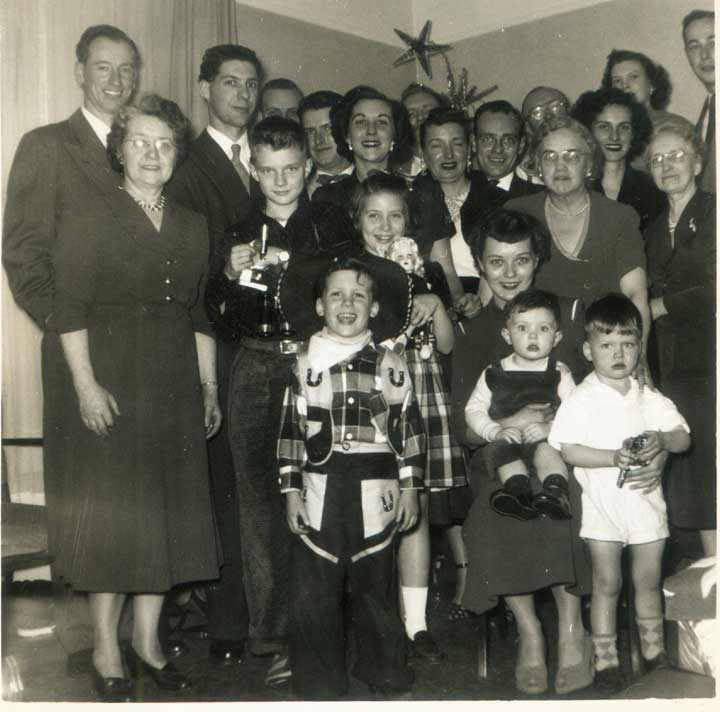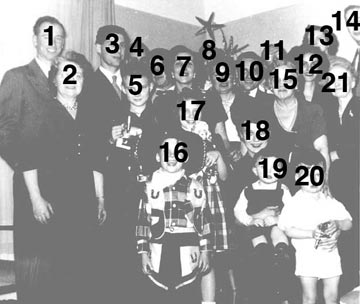
bottom
The Folks at 29 by Jim Low copyright 1985
It is warm and alive. It is a living family. This is home. "The Folks at 29" are unique. Walk into the living room and you find uncle Alex listening to his short wave radio, Aunt Grace knitting a sweater for a grand-niece, Aunt Isobel playing cards, and other members of the family conversing. As we follow the delicious odour to the kitchen, we find aunt Mina preparing a large roast beef dinner. In the dining room, several of her nieces are setting the table. We go upstairs. Here we find the nephews chatting, and getting ready for dinner. In one bedroom, we hear the clicking of a typewriter from aunt Tot's room.
"Ding-a-ling-a-ling." The dinner bell! Everyone rushes to the large dinning room table. No one would dare be late for dinner. Uncle Alex arrives at the head of the table, and all are seated except for aunt Mina. In a moment, aunt Mina enters and places the roast in front of uncle Alex, along with the trays and bowls of potatoes and vegetables. Aunt Mina then takes her place at the end of the table. We all bow our heads in silence as uncle Alex says grace. The dinner plates then start circling the table as uncle Alex serves dinner.
Let's see: who is with us tonight? At the main table is Alex ("Pop") and Mina ("Mom"). So are Mina's sisters Grace, Isobel, and Tot ("The Aunts"). Also at the table are the other regulars: nieces and nephews Lillian, Ruth, Muriel, Gordon, and Alan. Tonight, Alex and Mina's son Reed and his wife Ethel are also squeezed in at the table. At the card table in the corner are Reed's children Penny and Jim. Fourteen family members for dinner tonight. That's typical. But I have seen more.
After dinner, the women gather in the kitchen for cleanup. The days activities are discussed. Advise is sought and given. Conversations are stimulating. Cleanup time is all too short, for we need more time to talk.
Alex heads down the cellar with his grandson Jim. It's time to stoke the coal furnace for the night. Jim just loves getting the coal for Grandpa. And tonight, Jim discovers what Grandpa means when he uses the expression "down the cellar behind the axe!" There, behind the axe, is his little after-dinner drink. After all, we couldn't let the aunts know about that!
Back in the living room, Aunt Grace is getting Penny to try on the sweater being knitted. In a few days, Penny will have a sweater to match the mittens Aunt Grace knitted for her last month.
This describes only a few hours in the life of our family. Our home was a loving, living entity: more than the sum of its parts. While the individuals who made up this extended family changed over the half century of its existence, it was always considered home by those who touched it. Long after the the family moved from 29 Grosvenor, they were still referred to as "The Folks at 29."
Our home was unique. Parents, aunts, uncles, cousins, nephews, and nieces formed our extended family. The love and warmth in our family were not some abstract feelings. You could see and touch the affection that existed within our home.
During the 50's, the size of our family appeared to shrink. The younger ones left to set up their own families. But "29" was always home. It was a meeting place. The new families returned home regularly with their young ones. Almost daily, someone would return for a visit, for conversation, for advise, a meal, or a bed. Sunday dinners were bigger than ever. A second card table had to be set up for the extras. By the mid 1950's, you would often see two dozen family members at "29" on a weekend.
Although the older generation started passing on in 1959, the "The Folks at 29" continued for many years. "Home" existed for those who wished to return until 1970. In that year, the two surviving senior members, aunt Grace and Aunt Mina had to move to a nursing home. Even then, they received visitors from the rest of the family until 1979, when Aunt Mina died.
Yes, the previous description is an idealized family. It does not describe the problems. There were many personal disasters. We all had our human failings. But the important thing is that the family was there. We all learned from the experience - even the difficult parts of our lives eventually helped us to be better human beings.
Although the old home no longer exists, "The Folks at 29" still exist in our hearts. Our individual families remember the old "home." We still feel the influence of "29." Our lives are better for it. What we remember of life experiences is what directs our personalities. We learn, we interpret, and use this knowledge to better ourselves, our family, and society. Memories are vital to our existence. They not only tell us of our past, but prepare us for our future.
Remember the old dining room at "29"? The
large dining room table? The buffet? The china cabinet? The hutch? What
ever became of them? Walk into my dining room to-day, and you
will feel at home. For this room is filled with the furniture - and
the feelings - of "The Folks at 29".
Picture taken of "The Folks at 29" Christmas 1951.
Missing: Tot Tanner, who took the picture. Lillian
Tanner/Allman of Akron, who was pregnant and not travelling.

 |
1. Rev Johnson 2. Mina Tanner/Low 3. Tom Rutherford 4. Gordon Kirkpatrick 5. Jim Low 6. (unknown: friend of Gordon?) 7. Ruth Tanner/Johnson 8. Reed Low 9. Ethel Flinn/Low 10. Alan Kirkpatrick 11. Alex Low 12. Gay Collingwood/Rutherford 13. Barbara Rosenthal/Kirkpatrick 14. Martin Bannister 15. Isobel Tanner/Collingwood 16. Bill Rutherford 17. Penny Low 18. Muriel Kirkpatrick/Bannister 19. Reed Kirkpatrick 20. Bruce Rutherford 21. Grace Tanner |